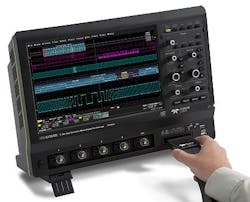Oscilloscopes for test and measurement of embedded systems offered by Teledyne LeCroy
CHESTNUT RIDGE, N.Y., 2 Dec. 2013. Teledyne LeCroy in Chestnut Ridge, N.Y., is introducing the HDO4000-MS and HDO6000-MS high-definition oscilloscopes for test & measurement of embedded systems.
The oscilloscopes combine 16 channels of mixed-signal capabilities with HD4096 high definition technology, long memory, and a compact form factor, in bandwidths from 200 MHz to 1 GHz.
All HDO models sport a large 12.1-inch touch-screen display and intuitive interface to enhance operation. Powerful debug tools, plus automatic measurements, and waveform math capabilities turn the HDO-MS oscilloscope into an all-in-one analog, digital, and serial debug machine.
With embedded systems growing more complex, powerful mixed-signal debug capabilities are an essential part of modern oscilloscopes, company officials say. In addition to 16 integrated digital channels, the HDO-MS oscilloscopes ship with a targeted set of digital debug tools.
Analog and digital cross pattern triggering, digital timing measurements, parallel pattern search, logic gate emulation and activity indicators help with precise circuit validation and fast debugging of complex embedded designs.
These features complement the HDO toolset which includes WaveScan search and find, history mode waveform playback, sequence acquisition mode, and LabNotebook report generation.
Spectrum-analysis and power-measurement software packages extend the oscilloscopes' capabilities while leveraging the 12-bit architecture with its wider dynamic range and improved measurement precision.
For more information contact Teledyne LeCroy online at http://teledynelecroy.com.

